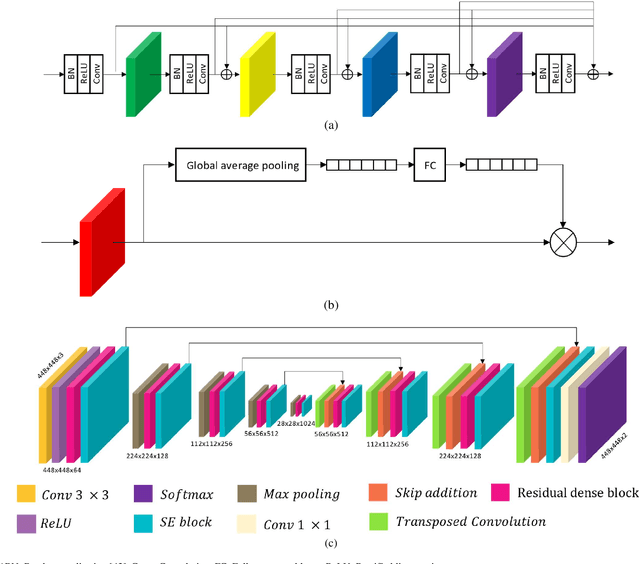Jae Youn Hwang
Deep Learning-based Synthetic High-Resolution In-Depth Imaging Using an Attachable Dual-element Endoscopic Ultrasound Probe
Sep 13, 2023



Abstract:Endoscopic ultrasound (EUS) imaging has a trade-off between resolution and penetration depth. By considering the in-vivo characteristics of human organs, it is necessary to provide clinicians with appropriate hardware specifications for precise diagnosis. Recently, super-resolution (SR) ultrasound imaging studies, including the SR task in deep learning fields, have been reported for enhancing ultrasound images. However, most of those studies did not consider ultrasound imaging natures, but rather they were conventional SR techniques based on downsampling of ultrasound images. In this study, we propose a novel deep learning-based high-resolution in-depth imaging probe capable of offering low- and high-frequency ultrasound image pairs. We developed an attachable dual-element EUS probe with customized low- and high-frequency ultrasound transducers under small hardware constraints. We also designed a special geared structure to enable the same image plane. The proposed system was evaluated with a wire phantom and a tissue-mimicking phantom. After the evaluation, 442 ultrasound image pairs from the tissue-mimicking phantom were acquired. We then applied several deep learning models to obtain synthetic high-resolution in-depth images, thus demonstrating the feasibility of our approach for clinical unmet needs. Furthermore, we quantitatively and qualitatively analyzed the results to find a suitable deep-learning model for our task. The obtained results demonstrate that our proposed dual-element EUS probe with an image-to-image translation network has the potential to provide synthetic high-frequency ultrasound images deep inside tissues.
Explainable Deep Learning Algorithm for Distinguishing Incomplete Kawasaki Disease by Coronary Artery Lesions on Echocardiographic Imaging
Apr 05, 2022



Abstract:Background and Objective: Incomplete Kawasaki disease (KD) has often been misdiagnosed due to a lack of the clinical manifestations of classic KD. However, it is associated with a markedly higher prevalence of coronary artery lesions. Identifying coronary artery lesions by echocardiography is important for the timely diagnosis of and favorable outcomes in KD. Moreover, similar to KD, coronavirus disease 2019, currently causing a worldwide pandemic, also manifests with fever; therefore, it is crucial at this moment that KD should be distinguished clearly among the febrile diseases in children. In this study, we aimed to validate a deep learning algorithm for classification of KD and other acute febrile diseases. Methods: We obtained coronary artery images by echocardiography of children (n = 88 for KD; n = 65 for pneumonia). We trained six deep learning networks (VGG19, Xception, ResNet50, ResNext50, SE-ResNet50, and SE-ResNext50) using the collected data. Results: SE-ResNext50 showed the best performance in terms of accuracy, specificity, and precision in the classification. SE-ResNext50 offered a precision of 76.35%, a sensitivity of 82.64%, and a specificity of 58.12%. Conclusions: The results of our study suggested that deep learning algorithms have similar performance to an experienced cardiologist in detecting coronary artery lesions to facilitate the diagnosis of KD.
Domain Adaptive Transfer Attack (DATA)-based Segmentation Networks for Building Extraction from Aerial Images
Apr 29, 2020



Abstract:Semantic segmentation models based on convolutional neural networks (CNNs) have gained much attention in relation to remote sensing and have achieved remarkable performance for the extraction of buildings from high-resolution aerial images. However, the issue of limited generalization for unseen images remains. When there is a domain gap between the training and test datasets, CNN-based segmentation models trained by a training dataset fail to segment buildings for the test dataset. In this paper, we propose segmentation networks based on a domain adaptive transfer attack (DATA) scheme for building extraction from aerial images. The proposed system combines the domain transfer and adversarial attack concepts. Based on the DATA scheme, the distribution of the input images can be shifted to that of the target images while turning images into adversarial examples against a target network. Defending adversarial examples adapted to the target domain can overcome the performance degradation due to the domain gap and increase the robustness of the segmentation model. Cross-dataset experiments and the ablation study are conducted for the three different datasets: the Inria aerial image labeling dataset, the Massachusetts building dataset, and the WHU East Asia dataset. Compared to the performance of the segmentation network without the DATA scheme, the proposed method shows improvements in the overall IoU. Moreover, it is verified that the proposed method outperforms even when compared to feature adaptation (FA) and output space adaptation (OSA).
 Add to Chrome
Add to Chrome Add to Firefox
Add to Firefox Add to Edge
Add to Edge